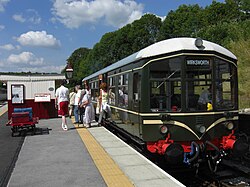This article needs additional citations for verification .(July 2024) |
| British Rail Derby Lightweight | |
|---|---|
 Derby Lightweight power car no. 79018 at Bewdley on the Severn Valley Railway | |
 The refurbished seating in the 2nd class saloons of the Trailer Car 79612 - 2021 | |
| In service | 1954-1969 |
| Manufacturer | BR Derby Works |
| Replaced | Steam locomotives and carriages |
| Constructed | 1954-1959 |
| Number built | 217 vehicles |
| Number preserved | 2 sets |
| Formation | 1, 2 & 4 car formations |
| Capacity | 16 1st + 53 3rd class (motor composite), 61 3rd class (motor third brake) |
| Operators | British Rail |
| Specifications | |
| Car length | 57 ft 6 in (17.53 m) |
| Doors | 2 on each side |
| Maximum speed | 62 mph (100 km/h) |
| Weight | 27 tonnes (26.6 long tons; 29.8 short tons) power car |
| Prime mover(s) | Two BUT |
| Power output | (AEC) 125 bhp (93 kW) (79000-79007, 79500-79507) BUT (AEC) 150 bhp (110 kW) (remainder) |
| Transmission | Hydraulic (79000-79007, 79500-79507) Mechanical 4-speed epicyclic gearbox (remainder) |
| Multiple working | ▲ Red Triangle (79000-79007, 79500-79507) ◆ Yellow Diamond (remainder) |
| Track gauge | 1,435 mm (4 ft 8+1⁄2 in) standard gauge |

The British Rail Derby Lightweight diesel multiple units were the first such trains to be built en-masse for British Railways. The units were built at BR's Derby Works from 1954 to 1955. The units were built in various formations, including 12 power-twin 2-car units, 84 power-trailer 2-car units, four 4-car units, and two single car units.
Contents
- Operations
- Formations
- Power Twins
- Power Trailers
- Four Car Units
- Single Car Units
- Powertrain
- Power Twins 79000+79500 to 79007+79507
- Remainder of the fleet
- Departmental Use
- Preservation
- See also
- References
- Further reading
- External links
Body framing was extruded and riveted together. Panelling was welded into continuous sheets and riveted to the frame. Luggage racks were light alloy. The floors had 2 layers of flameproof hardboard, covered with linoleum. To reduce noise and condensation, the inside structure and undersides were sprayed with asbestos. Lighting was by 60-watt, 24-volt lamps charged by belt driven dynamos. Heating was oil fired. Standard mild steel bogies ran on Timken roller bearings. [1]
Contemporaneous with these units was the unique Battery Electric Multiple Unit.
